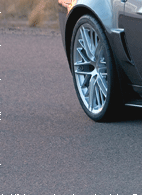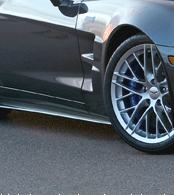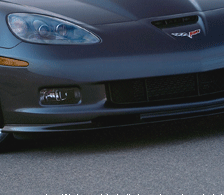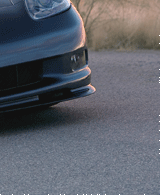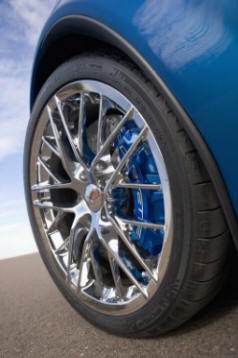 While
the exposed carbon-fiber
elements and windowed
hood symbolize the car's
character, there are
numerous other design
details that are less
obvious yet no less
important to the ZR1's
performance. They
include:
While
the exposed carbon-fiber
elements and windowed
hood symbolize the car's
character, there are
numerous other design
details that are less
obvious yet no less
important to the ZR1's
performance. They
include:
-
Carbon-fiber front fenders widened to accommodate the ZR1's larger front wheels and tires
-
ZR1-specific twin vents in the front fenders
-
Full-width rear spoiler with raised outboard sections incorporates the center high-mounted stop lamp
-
ZR1-specific 20-spoke alloy wheels in Sterling Silver (chrome available)
-
Nineteen-inch front wheels and 20-inch rear wheels inspired by C6R racecars
-
Michelin Pilot Sport 2 tires; P285/30ZR19 in front and P335/25ZR20 in the rear
-
ZR1-specifc blue-painted brake rotors visible through the wheels
“The ZR1 has a performance-driven design,” said Bennion. “There is an aesthetic element to all of the unique features, but they were developed first and foremost to support the car's performance capability.”
Bennion cites the front splitter and rear spoiler as prime examples.
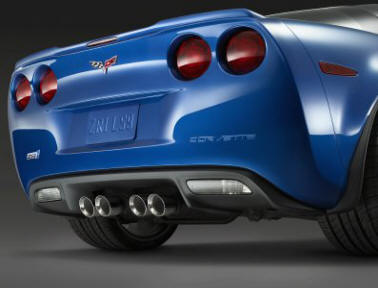 “Because
of its top-speed and
handling capabilities,
the ZR1 requires more
downforce than the Z06,
and the splitter and
rear spoiler were
carefully shaped and
wind-tunnel tested to
meet that requirement,”
he said. “The front
fenders were widened to
cover the wider wheels
and their new,
twin-outlet vents
provide a path for hot
air to escape.”
“Because
of its top-speed and
handling capabilities,
the ZR1 requires more
downforce than the Z06,
and the splitter and
rear spoiler were
carefully shaped and
wind-tunnel tested to
meet that requirement,”
he said. “The front
fenders were widened to
cover the wider wheels
and their new,
twin-outlet vents
provide a path for hot
air to escape.”
The ZR1 shares the front fascia with the Z06, but the brake-cooling ducts are revised to channel more air to the brakes. Even the front suspension's A-arms were aerodynamically optimized – they feature air deflectors that direct air to the carbon-ceramic brake rotors.
The ZR1 is available in seven exterior colors, including: Black, Velocity Yellow Tintcoat, Victory Red, Atomic Orange Metallic, Jetstream Blue Metallic Tintcoat and two new colors – Blade Silver Metallic and Cyber Gray Metallic.
Exposed carbon-fiber
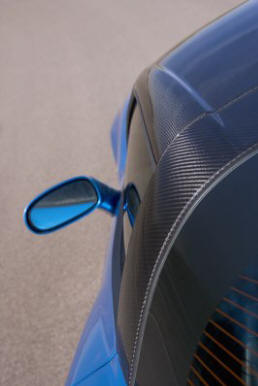 A
lightweight material
pioneered in racing
circles, carbon-fiber
has an undeniable air of
exoticness and only a
few production cars have
ever employed the
relatively expensive
composite in their
exterior panels. The
2004 Corvette Z06
Commemorative Edition
featured a carbon-fiber
outer hood and the
current Z06 has
carbon-fiber fenders and
floor panels.
A
lightweight material
pioneered in racing
circles, carbon-fiber
has an undeniable air of
exoticness and only a
few production cars have
ever employed the
relatively expensive
composite in their
exterior panels. The
2004 Corvette Z06
Commemorative Edition
featured a carbon-fiber
outer hood and the
current Z06 has
carbon-fiber fenders and
floor panels.
On the ZR1, the roof panel, roof bow, lower rocker moldings, front splitter and the underside of the hood feature exposed-weave carbon-fiber. The other carbon-fiber parts of the ZR1 include the front fenders and hood. The front fascia, doors, rear fenders and rear fascia are made of various other composite materials and all are painted body-color.
The carbon-fiber panels contribute to the car's visual identity – particularly the exposed-weave panels – but they also serve an important purpose: They save weight. The carbon-fiber roof panel and roof bow, for example, weigh about 7.7 pounds (3.5 kg) less than the already lightweight composite panels on the Corvette Z06.
Ironically, the
identifiable and
intricate weave pattern
of carbon-fiber on most
production cars is
hidden beneath a shell
of paint, because the
weave is very
susceptible to
ultra-violet (UV) light
damage, which can cause
yellowing or a generally
dull appearance. But
thanks to a specially
developed material that
ensures a deep, lustrous
and long-lasting finish,
the '09 ZR1's
exposed-weave panels
feature a clear coat
that protects like
paint.
“The clear coat is applied to the exposed carbon-fiber panels that are exposed to sunlight,” said Mark Voss, designing engineer. “In addition to preventing damaging UV rays, the coating has the chip and scratch resistance of conventional paint.”
The special clear coat, which is a proprietary product developed by a GM supplier for the ZR1 program, gives the carbon-fiber parts a shiny, almost wet finish that adds to the visual depth of the weave pattern.
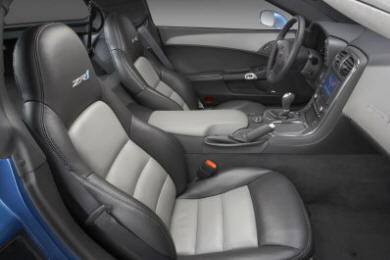 Interior
details
Interior
details
The ZR1's interior
builds on the brand's
dual-cockpit heritage,
with high-quality
materials, craftsmanship
and functionality that
support the
premium-quality
experience promised by
the car's performance.
The ZR1's cabin differs
from the Corvette and
Corvette Z06 with the
following:
- ZR1-logo sill plates
- ZR1-logo headrest embroidery
- Specific gauge cluster with “ZR1” logo on the tachometer and a 220-mph (370 km/h) readout on the speedometer
- Boost gauge added to the instrument cluster and head-up display
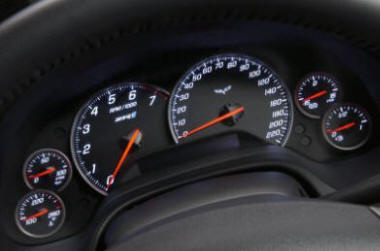 |
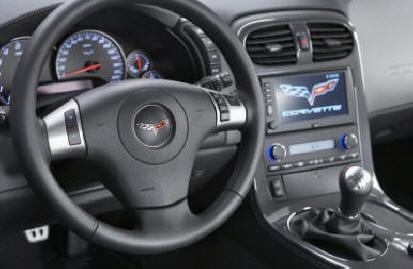 |


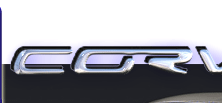
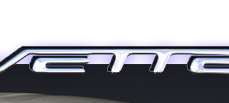
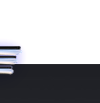
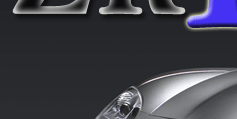

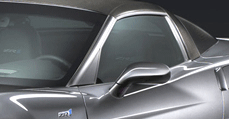
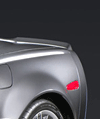








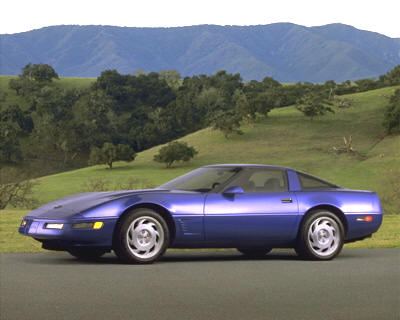 In
1990, the Corvette ZR-1 caused a stir with its wider
quarter panels, convex rear fascia and squared
taillamps. They were the visual clues that
identified the special car, enhancing its status as
an instant legend.
In
1990, the Corvette ZR-1 caused a stir with its wider
quarter panels, convex rear fascia and squared
taillamps. They were the visual clues that
identified the special car, enhancing its status as
an instant legend. 



